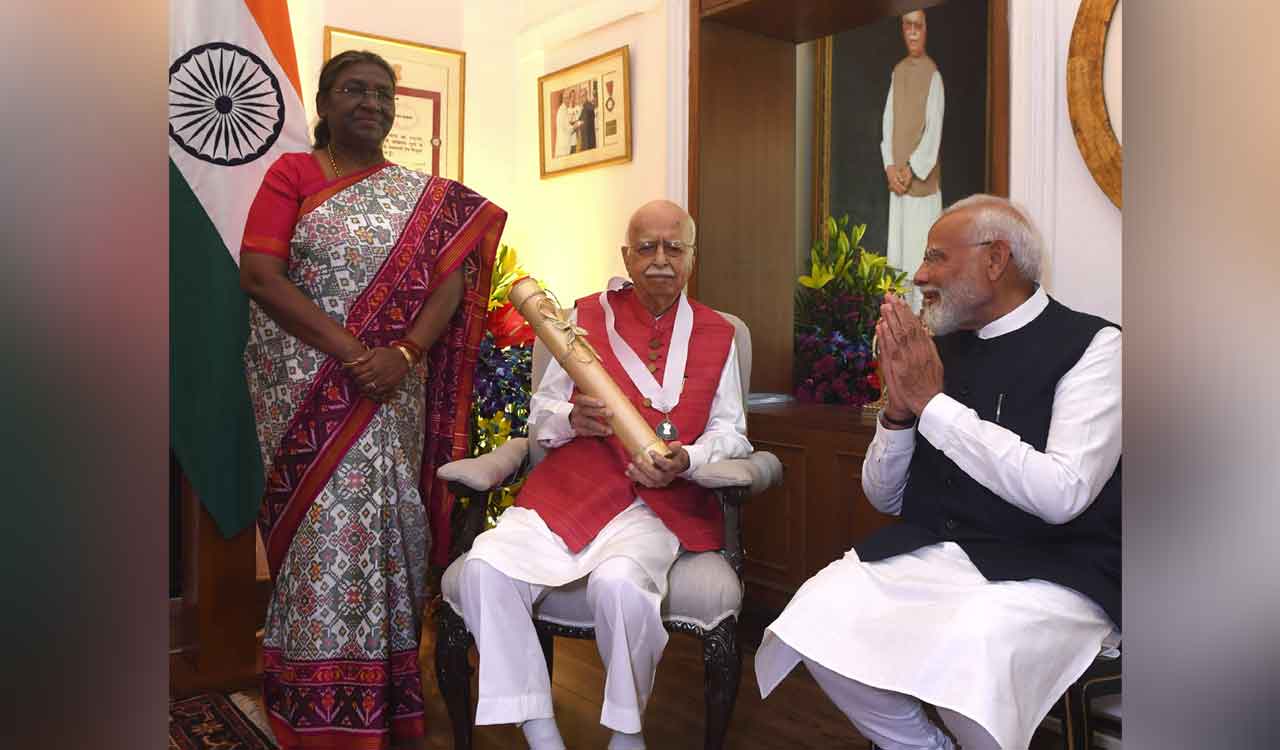
The nation's highest civilian award was given to Advani at his official residence on Easter Sunday, the day the Bharatiya Janata Party (BJP) was formed in 1980.
Published Date - 31 March 2024, 01:28 PM
New Delhi: The gates of 30 Prithviraj Road in Delhi on Sunday opened to welcome President Droupadi Murmu, Vice President Jagdeep Dhankhar, Prime Minister Narendra Modi, former Vice President M. Venkaiah Naidu, and a host of other dignitaries to script a glorious chapter in the life and times of 96-year-old former Deputy Prime Minister, Lal Krishna Advani, by conferring the Bharat Ratna award on the BJP stalwart.
Coincidentally, the nation’s highest civilian award was given to Advani at his official residence on Easter Sunday, the day the Bharatiya Janata Party (BJP) was formed in 1980.
Those who have known Advani closely have often heard an interesting anecdote.
The Jan Sangh, which had merged with the Janata Party in 1976 separated from it because of the bickering noises over “dual membership” (continued alignment with the RSS despite being in Janata Party) on April 4, 1980, on Good Friday, the day Jesus was crucified. And it came in a new avatar, re-christened as the Bharatiya Janata Party, on April 6, 1980, on Easter Sunday, the day celebrated for Jesus’ resurrection.
Advani, along with Atal Bihari Vajpayee, was the founder of the BJP. And the symbolism of it was never missed by him.
India and Indian politics has always been stigmatised by caste, region, social background etc. And Advani’s story is unique for the BJP and for contemporary Indian political history — breaking many stereotypes.
From being a non-Hindi speaking Sindhi studying in the Christian missionary — St Patrick’s School in Karachi, and yet opting for the RSS, migrating to India from Pakistan post the Partition, gradually rising up the ladder in the organisation, transforming the shape of Indian politics through his Ram Rath Yatra in 1990, to unleashing the biggest public mobilisation and debate in Independent India — Advani’s long political career has been unique.
The quintessential charioteer not only took out his Yatra for the construction of a ‘Bhavya’ Ram temple at the perceived Ram Janmabhoomi site in Ayodhya, but also challenged the existing political and so-called intellectual system with the coinage of words like ‘pseudo-secularism’, ‘appeasement politics’, ‘cultural nationalism’, differentiating between ‘Swaraj’ (independence) and ‘Suraj’ (good governance), etc.
Incidentally, Narendra Modi, the incumbent Prime Minister for 10 years, then as a young party leader was the organiser of the first leg of Advani’s Rath Yatra from Somnath to Ayodhya, making it a huge success from the starting point itself.
Narendra Modi was also with Advani when the latter was arrested a month later by Lalu Prasad after the Yatra reached Sitamarhi in Bihar and was about to cross the border to Uttar Pradesh. The arrest made the BJP bring down the V.P. Singh government at the Centre.
It marked two things.
First, a first-of-its-kind backroom arrangement of two ideological extremes, the BJP and the CPI (M)-led Left Front coming together to support a coalition government falling apart.
Second, the subsequent turn of events which forced the parliamentary elections in 1992 in a span of less than three years to benefit the BJP.
In the first elections after the formation of the BJP in 1984, held in the immediate aftermath of the assassination of then Prime Minister Indira Gandhi, the party got only two Lok Sabha seats as opposed to Congress’ 400-plus tally.
There were many who would tell him, “Advani ji, dukan badh kar do (shut the shop).”
But it’s a saga of tremendous grit, hard work, vision, and ability to reinvent on the part of the Vajpayee-Advani duo that the BJP marched on to break new barriers and breach social and geographical boundaries.
With Advani at the helm of the organisation as the party President (longest serving), the BJP in 1989 catapulted to 86 seats. In the 1992 elections, the tally swelled further to 121 seats.
Post the Ram Rath Yatra, Advani’s popularity was at its peak among the masses and within the Sangh Parivar as the most acceptable face in the BJP. Yet, at a party convention in Mumbai in 1995, he abruptly made a declaration that Vajpayee should be the Prime Minister, and not him, if the BJP gets the right numbers to form the government at the Centre.
The announcement caught the party leaders and workers by complete surprise.
The 1996 elections were a landmark moment for the BJP when it became the single-largest party with 161 seats. This was the time when the first BJP-led government was formed at the Centre with Vajpayee as the Prime Minister and Advani as the Home Minister. But the government lasted for just 13 days.
The experience made Advani go and look for allies by the time the next elections took place, as the BJP-led National Democratic Alliance came into existence.
In 1998, the BJP increased its numbers in the Lok Sabha to 182, as the NDA 1.0 came to power for a longer term. The rest is history.
There perhaps couldn’t have been a better occasion for Advani and his admirers than this — Prime Minister Modi announcing Bharat Ratna for him just ahead of the inauguration of the Ram Temple in Ayodhya, the ‘Mandir Wahin Banayenge’ dream coming true, and the award conferred on him on this momentous day, on which 44 years ago he played a most instrumental role in forming the BJP.





Leave a Reply